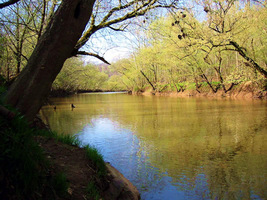 | Back to e-WV
| Back to e-WV
 The West Virginia Encyclopedia
The West Virginia Encyclopedia
 | Back to e-WV
| Back to e-WV
 The West Virginia Encyclopedia
The West Virginia Encyclopedia

Gilmer County, located in the heart of West Virginia, was established on February 3, 1845, from parts of Kanawha and Lewis counties. It was named for Thomas W. Gilmer, a governor of Virginia. Gilmer County has an area of 339.7 square miles and a 2020 population of 7,408.
Organization of the county government began at the home of Salathiel Stalnaker in DeKalb. Citizens voted to establish the county seat at a place known as ‘‘The Ford,’’ now Glenville. A disagreement about which community to use until a courthouse was built resulted in furtive maneuvering that spawned wild stories. Both were on a road that had been an old Indian trail (now State Route 5) along the Little Kanawha River toward Parkersburg, but a turnpike (now U.S. 33-U.S. 119) from Point Pleasant to Weston crossed at The Ford, giving it an advantage over DeKalb. The town of Glenville was laid out there in 1845.
The Little Kanawha provided transportation for people and commerce, and the river and its tributaries provided power for mills. Farming was the chief local occupation until timber, coal, oil, and gas were developed. Raising sheep, cattle, and tobacco gradually declined, although Gilmer remains a farming county. Its population peaked in 1940 and has declined since that time.
Gilmer County had mixed allegiances during the Civil War and suffered from guerrilla warfare. Fort Moore, a Union stockade, overlooked the Little Kanawha River atop College Hill in Glenville. Built in the spring of 1864 for Capt. W. T. Wiant’s home guards to protect the community, it was burned that December by a Confederate unit under Capt. Sida Campbell. The slavery issue caused a split in Pisgah Methodist Episcopal Church in the 1850s. The ensuing Job’s Temple, now the oldest church building in Gilmer County, is listed in the National Register of Historic Places.
Our first official state song, ‘‘The West Virginia Hills,’’ was created in the hills of Gilmer County. It was written by Ellen Ruddell King while visiting relatives in Glenville. Her poem was put to music by Henry Everett Engle in 1885, at Engle’s farm near Tanner. Engle also added the chorus. ‘‘The West Virginia Hills’’ was first published in the Glenville Crescent newspaper in September 1885.
Glenville State University began in 1872 as a branch of the State Normal School. The first session opened in January 1873 in the old Gilmer County courthouse, with T. Marcellus Marshall as acting principal. By 1939 there were 55 one-room schools in the county, and a few larger ones. Eventually there were five high schools. In 1968, they were consolidated into Gilmer County High School. The Calhoun-Gilmer Career Center is an important educational resource for both counties.
Although not navigable by modern standards, the Little Kanawha River remains important to Gilmer County and has a large place in local history. Rafts, flatboats and, later, gasoline-powered paddlewheel boats carried goods and passengers until decent roads were provided in the 1930s. Between 1890 and 1931, barges carrying as much as 30,000 pounds and boats carrying 50 to 100 passengers were a regular sight. Outgoing freight included the county’s timber and coal. The Gainers were prominent rivermen, and two of the other boat companies were owned by John Shuman and Clyde Conrad. The boats hauled dry goods, supplies for the growing natural gas industry, and other products into the valley. Models of boats built in the county are on display at the Gilmer County Historical Society.
The river’s importance to county history is underscored by the fact that three of Gilmer’s Little Kanawha bridges are in the National Register of Historic Places. They are of three distinct structural types, including the camel-back truss bridge at Stouts Mills, the Pratt truss bridge at Glenville, and the cable suspension bridge at Trubada.
A medium security federal prison opened in 2003, replacing the the university as the largest employer in the county. An industrial park was established at Stouts Mills to stimulate economic development. U.S. 33 and U.S. 119 run together through the county. State Routes 5, 47, and a short section of 74 also pass through. Scenic roads include Cedar Creek Road (County Route 17, a West Virginia scenic backway) and the Little Kanawha Parkway (Route 5, a scenic byway). As of 2022, Gilmer County’s largest employers were, respectively, the federal prison system, the university, the county school system, Flying W Plastics, and Council of Senior Citizens of Gilmer County.
Flooding of the Little Kanawha River is a recurring problem. High water in November 1985 reached 13 feet above flood stage at Glenville, the highest on record, allowing boaters on Main Street to touch the traffic light. Permanent water marks may be seen on brick buildings in town. Until 1985, the big flood of March 1967 had been considered the flood of the century. There were rowboats on Main Street that year as well, and again in 1994. The river is a source of water for public utility plants. The Little Kanawha is used for fishing, with an occasional canoe or johnboat. Migrating waterfowl attract hunters in season.
Cedar Creek State Park offers camping, hiking trails, fishing, swimming, picnic pavilions, miniature golf, and a restored one-room schoolhouse. The annual West Virginia State Folk Festival, founded in 1950 by Dr. Patrick Ward Gainer, draws crowds to Glenville each June.
Written by Frances Myers Schmetzer
Gilmer County Historical Society. History of Gilmer County, West Virginia, 1845-1989. Marceline, MO: Walsworth Pub., 1994.
Moss, Margaret Knisley. Gilmer County One-Room Schools, 1873-1955. Glenville: 1998.
Wells, Nelson L. & Charles Holt. Lighthouse on the Hill: Glenville State College, 1872-1997. Virginia Beach: Donning Co., 1997.